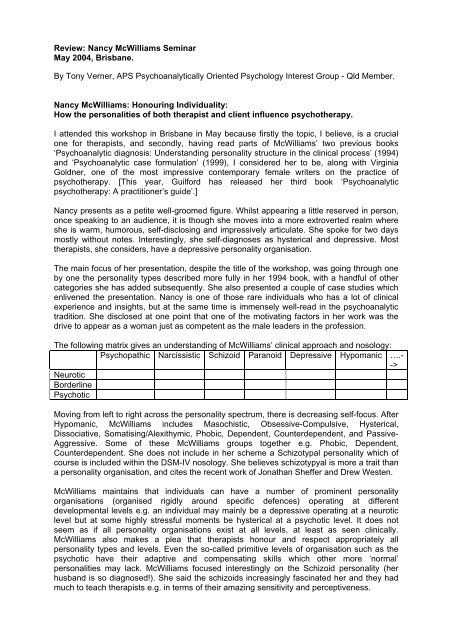Review: Nancy McWilliams Seminar - APS Member Groups
Review: Nancy McWilliams Seminar - APS Member Groups
Review: Nancy McWilliams Seminar - APS Member Groups
Create successful ePaper yourself
Turn your PDF publications into a flip-book with our unique Google optimized e-Paper software.
<strong>Review</strong>: <strong>Nancy</strong> <strong>McWilliams</strong> <strong>Seminar</strong>May 2004, Brisbane.By Tony Verner, <strong>APS</strong> Psychoanalytically Oriented Psychology Interest Group - Qld <strong>Member</strong>.<strong>Nancy</strong> <strong>McWilliams</strong>: Honouring Individuality:How the personalities of both therapist and client influence psychotherapy.I attended this workshop in Brisbane in May because firstly the topic, I believe, is a crucialone for therapists, and secondly, having read parts of <strong>McWilliams</strong>’ two previous books‘Psychoanalytic diagnosis: Understanding personality structure in the clinical process’ (1994)and ‘Psychoanalytic case formulation’ (1999), I considered her to be, along with VirginiaGoldner, one of the most impressive contemporary female writers on the practice ofpsychotherapy. [This year, Guilford has released her third book ‘Psychoanalyticpsychotherapy: A practitioner’s guide’.]<strong>Nancy</strong> presents as a petite well-groomed figure. Whilst appearing a little reserved in person,once speaking to an audience, it is though she moves into a more extroverted realm whereshe is warm, humorous, self-disclosing and impressively articulate. She spoke for two daysmostly without notes. Interestingly, she self-diagnoses as hysterical and depressive. Mosttherapists, she considers, have a depressive personality organisation.The main focus of her presentation, despite the title of the workshop, was going through oneby one the personality types described more fully in her 1994 book, with a handful of othercategories she has added subsequently. She also presented a couple of case studies whichenlivened the presentation. <strong>Nancy</strong> is one of those rare individuals who has a lot of clinicalexperience and insights, but at the same time is immensely well-read in the psychoanalytictradition. She disclosed at one point that one of the motivating factors in her work was thedrive to appear as a woman just as competent as the male leaders in the profession.The following matrix gives an understanding of <strong>McWilliams</strong>’ clinical approach and nosology:Psychopathic Narcissistic Schizoid Paranoid Depressive Hypomanic ….-->NeuroticBorderlinePsychoticMoving from left to right across the personality spectrum, there is decreasing self-focus. AfterHypomanic, <strong>McWilliams</strong> includes Masochistic, Obsessive-Compulsive, Hysterical,Dissociative, Somatising/Alexithymic, Phobic, Dependent, Counterdependent, and Passive-Aggressive. Some of these <strong>McWilliams</strong> groups together e.g. Phobic, Dependent,Counterdependent. She does not include in her scheme a Schizotypal personality which ofcourse is included within the DSM-IV nosology. She believes schizotypyal is more a trait thana personality organisation, and cites the recent work of Jonathan Sheffer and Drew Westen.<strong>McWilliams</strong> maintains that individuals can have a number of prominent personalityorganisations (organised rigidly around specific defences) operating at differentdevelopmental levels e.g. an individual may mainly be a depressive operating at a neuroticlevel but at some highly stressful moments be hysterical at a psychotic level. It does notseem as if all personality organisations exist at all levels, at least as seen clinically.<strong>McWilliams</strong> also makes a plea that therapists honour and respect appropriately allpersonality types and levels. Even the so-called primitive levels of organisation such as thepsychotic have their adaptive and compensating skills which other more ‘normal’personalities may lack. <strong>McWilliams</strong> focused interestingly on the Schizoid personality (herhusband is so diagnosed!). She said the schizoids increasingly fascinated her and they hadmuch to teach therapists e.g. in terms of their amazing sensitivity and perceptiveness.
Therapeutically, <strong>McWilliams</strong> relies on her countertransference to guide her in thepsychoanalytic diagnosis of personality organisation of each client. With a Paranoid she willfeel threatened, with a Narcissist evaluated, with an Hysteric warm, and so on. She insistshowever on seeing each client as an individual rather than a type. She will vary her approachto each client depending on her understanding of the client’s dominant personalityorganisation. For example, with psychopaths she will go out of her way in the early sessionsto project to the client how powerful and smart she is, reckoning that psychopathic types willnot respect nor work with her otherwise.<strong>McWilliams</strong> in her case descriptions displayed an awesome ability to empathise with theclient and to choose her language exquisitely sensitively. Her long years of clinicalexperience and her encyclopaedic knowledge of the psychoanalytic and psychologicalliterature on personality development and pathology no doubt contribute to this ability. Itseems to me though that all the theory in the world and the most nuanced theoretical modelsare to no avail without the intuitive capacity to select the right words with the right clients atthe right time. I am reminded here of Paul Wachtel’s inspirational ‘Therapeuticcommunication: Principles and effective practice’ (1993).Finally, some quibbles. As mentioned earlier, there was too little on the influence of thetherapist’s personality and the interaction with the client’s personality. And apart from theself-other dimension there are no underlying factors to help systematize what is a verycomplex array of personality organisations from Psychopathic to Passive-Aggressive. Itpresumably is now second nature to <strong>McWilliams</strong> to fairly quickly put her clients into aparticular category, but this is after a lifetime of experience, reading, writing and reflecting onthe many varied personality types as manifested in the therapy room. Other therapistsincluding this one probably could benefit from some simpler heuristic. I think Ted Millon(1996) ‘Disorders of personality: DSM-IV and beyond’ and (1999) ‘Personality-guidedtherapy’ offers some helpful guidance in this regard. He posits that all personalities can beclassified as varying along three dimensions: not just self/other, but also passive/active, andpleasure seeking/pain avoiding.‘Personality’, ‘Character’, ‘Temperament’, pooh-poohed by the behaviourists and later byWalter Mischel in particular, have been unfairly consigned by psychologists to the historicaldust-heap. The messiness of Axis II reflects this neglect. <strong>McWilliams</strong> is to be congratulatedfor her continuing work in this area.Tony Verner (moira@quicknet.com.au -- Any thoughts or feedback gratefully received)© A. Verner, 2004.
















